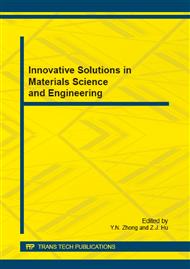p.3
p.7
p.12
p.17
p.21
p.27
p.31
p.35
Effects on Temperature-Induced Phase Transition of Ni2MnGa Polycrystalline Ferromagnetic Shape Memory Alloys
Abstract:
Ferromagnetic shape memory alloy is a kind of new smart material. Directional solidification method in producing polycrystalline Ni2MnGa is mature and effective. In order to increase the strain of Ni2MnGa polycrystalline prepared by directional solidification, mechanical training is an effective method. In this paper, the tests of temperature-induced strain are carried out in different directions of Ni2MnGa prepared by directional solidification using three kinds of specimens with various mechanical training. Through analyzing the mechanical properties in different directions, the influence of mechanical training on the temperature-induced strain are investigated. Some conclusions which may provide references for the engineering applications of this material are gained.
Info:
Periodical:
Pages:
12-16
Citation:
Online since:
November 2014
Authors:
Price:
Сopyright:
© 2015 Trans Tech Publications Ltd. All Rights Reserved
Share:
Citation:


